This post may contain affiliate links. If you use these links to buy something we may earn a commission. Thanks.
Wine Cap mushrooms, also known as Garden Giant (Stropharia rugosoannulata), have gained popularity among home gardeners who wish to companion plant their food forests or perennial gardens to the next level.
Not only does their ability to break down mulch enrich the soil but the mycelium networks create a symbiotic relationship to further benefit your plants!
Plus, combinations of certain plants can also help minimize the occurrence of pests from eating your mushrooms!
In this article, we will explore: the companion benefits, suitable companions, planting arrangements and techniques, characteristics, and uses of wine cap mushrooms. (For a discount on wine cap mushroom spawn, use QUALITYSPAWN at checkout.)
Get started: Grow a Mushroom Garden at Home in 4 Steps
Disclaimer: Even if you intentionally inoculate your garden with wine caps, be sure to do your own research when harvesting to ensure you have the correct mushroom.
What is companion planting?
Companion planting is a gardening technique that involves interplanting various types of plants, and in this case, fungi, in close proximity to one another to enhance the overall health, growth, and productivity of the garden.
Perennial gardens thrive on fungal-dominated soil and wine caps happen to be an edible type of fungi. So they’ll benefit both you and the garden!
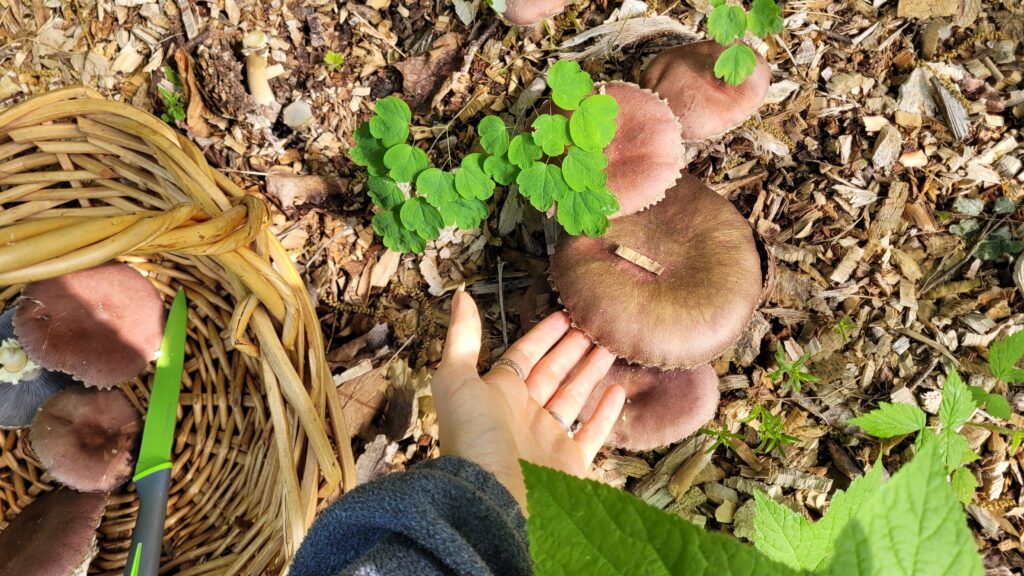
Benefits of Companion Planting with Wine Cap Mushrooms
Young food forests or gardens benefit most from the introduction of wine caps because they speed up decomposition. As mulch breaks down quickly, more nutrients will become available for your plants to grow.
Nutrient-rich soil is fertile soil, and plants with fertile soil become healthy and vigorous!
Vigorous and healthy plants are harder for pests and diseases to ‘infiltrate.’
Finally, wine caps contribute to ecological diversity and it’s always nice having a new edible species in the landscape!
Suitable Companion Plants for Wine Cap Mushrooms

People who grow wine cap mushrooms usually have one or two goals in mind.
- Everyone’s goal is to increase the rate of nutrient cycling in their garden
- Most, but not everyone’s other goal, is to harvest and eat wine caps
If your primary goal includes eating wine caps, some considerations could eliminate pests.
A few growers have experienced pests that gobble up their wine caps before they get a chance to add them to the dinner table. Most often, it’s been reported as slugs. I’ve seen a slug knawing at our wine caps before in a straw-heavy bed.
Slugs often love hanging out in areas with straw and leaves. Straw is often used and recommended to hasten and increase wine cap yields, and leaves are usually always around.
So if slugs are in your gardens already, consider first, omitting the use of straw, second, adding twig piles or protective rock formations around the garden to encourage reptiles and third, companion planting!
Slugs and other pests don’t tend to favor pungent or strong-scented plants. As part of your strategy, you could include plants such as lamb’s ears, lavender, fennel, ferns, wormwood, rosemary, and alliums.
For growers who struggle with healthy plants and fruit trees, grow a willow tree, or source willow mulch to feed your wine caps. Willow trees grow very fast and provide a lot of mulch.
The Canadian Organic Growers charity has tested to see the effect of willow mulch on food-producing perennials. In their studies, they found that fruit yields and survival rates increased by remarkable amounts.
Willow species such as Salix daphnoides contain high amounts of salicylic acid—the compound, they are saying, is responsible for resilient plants.
Wine cap mushrooms will gladly gobble up willow mulch so as more salicylic acid becomes available, it’s a win-win-win.
Related: Complete Guide to Grow and Use Wine Cap Mushrooms
Planting Arrangements and Techniques
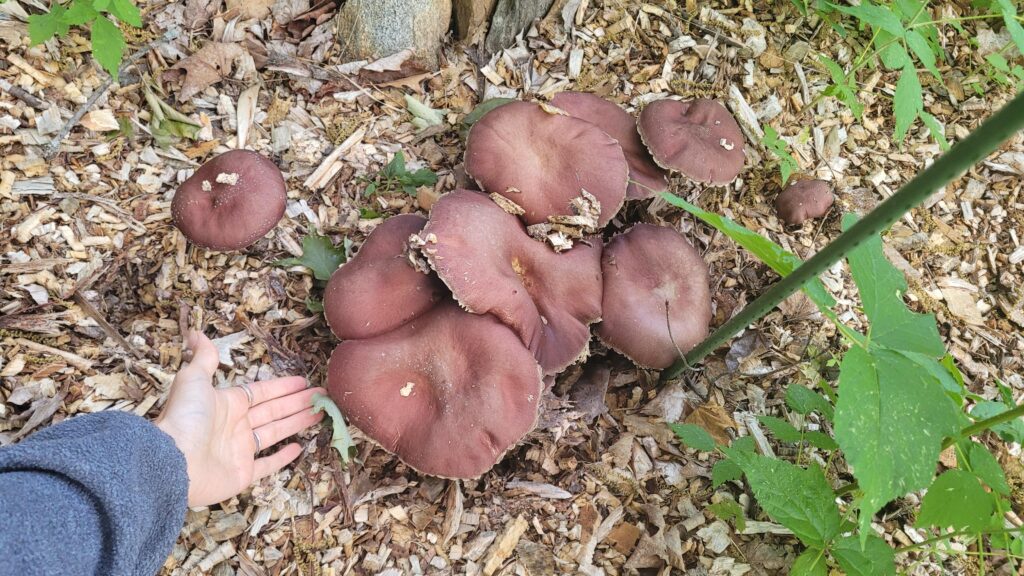
Planting arrangements
- Acanthocytes (produced by wine caps) consume nematodes which can protect root crops
- Slug-resistant plants—they are pleasant to be around.
So the point is—When inoculating a perennial garden with wine caps, you’ll want to avoid putting them near the spikey seabuckthorns or any area that is hard to reach or will be hard to reach.
- Open spaces make mushrooms easy to find and harvest
- Give plants the recommended space to avoid overcrowding and allow airflow to wick away excessive moisture.
- If you have a food forest, plant fast-growing sacrificial trees
Sumac and willow for example are fast-growing species that offer a lot of wood material! If woodchips aren’t free where you live, then grow your own!
You don’t need a chipper if you clip the 2-year-old branches into multiple pieces with pruning sheers.
Planting techniques
- Correct mulching is vital for healthy plants—Over-mulching will lead to oxygen-starved plants.
Wine cap mushrooms are best inoculated in between plants, in open spaces. This ensures you’ll be able to keep mulch clear from the base of all your plants.
See: The 20 Ultimate Rules to Mulching (Make No Mistakes)
Keep mulch no more than 6 inches in thickness when introducing wine cap spawn—4 inches is best. (use QUALITYSPAWN for discounted mushroom spawn)
- When adding mushroom spawn to woodchips, do so in layers and always maintain moisture.
See: How do you make (and maintain) an outdoor mushroom bed?
- Consider using a mix of straw, leaves, and woodchips to speed up fruiting
- Use a mix of particle sizes
The best mulch for any mushroom beds, including wine caps have a mix of sizes. Mixed-sized pieces of mulch allow for longer moisture retention.
- Use fresh organic matter to make mushrooms beds. That includes any woodchips, straw, and any other organic mulch material.
- Wine cap mushrooms prefer to have access to woodchips. Other substrates can be used in combination with woodchips as they aren’t picky eaters, but woodchips is a rich and long-lasting source of energy.
Care and Maintenance of Wine Cap and Companion Plants
Once you inoculate mulch with wine caps, the only care required until fruiting is consistent moisture!
In a shaded area, mulch doesn’t require watering, so mushroom bed placement is key! With good placement, caring for wine caps is very hands-free.
Eventually, however, wine caps will eat up the mulch and stop fruiting.
To maintain mushrooms year after year, you’ll need to feed wine cap beds continuously. Simply add a new layer of fresh mulch on top of the old, every year.
Wine Cap Mushroom Characteristics
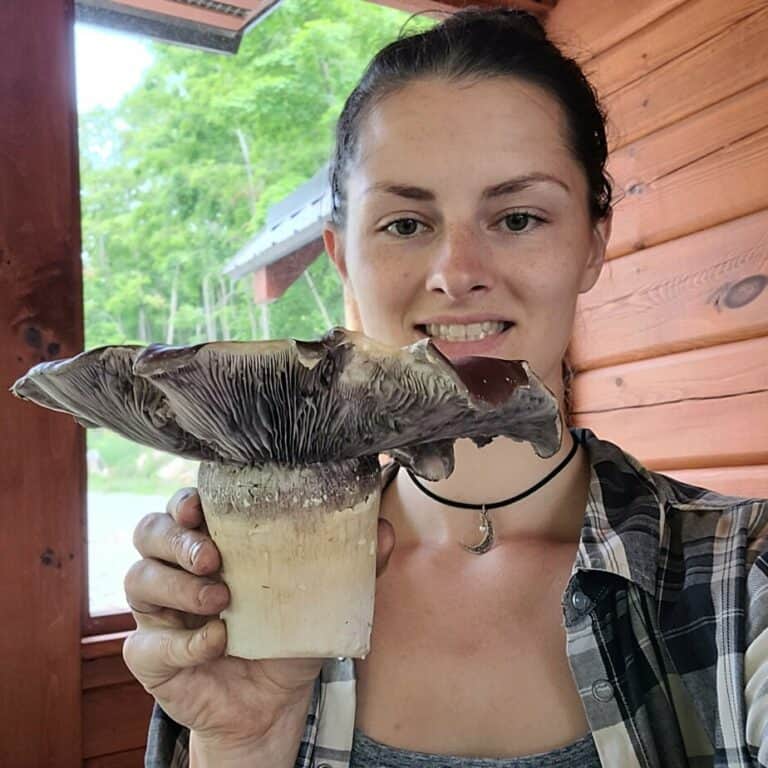
Disclaimer: Even if you intentionally inoculate your garden with wine caps, be sure to do your own research when harvesting to ensure you have the correct mushroom. This information does not replace your own judgement when deciding to consume any mushroom.
Wine cap mushrooms can be found naturally in hardwooded areas with plenty of composed woody debris. Composed wood, chips, and sticks are eventually colonized by wine caps and decomposed as the mushrooms vegetate and fruit.
Wine cap mushrooms range in sizes and shapes and appear a bit differently at each stage of growth. Some characteristics, however, are consistent with each stage.
- Wine caps in general, all have white stems that can be thick or thin. The tops range from a beige to red wine color and both colors can occur from the same wine cap strain.
- The biggest indicator of a true wine cap, in combination with the characteristics above, is the dark purple gills and spore print.
- Young wine caps have a white veil that covers the purple spores, and as they mature it quickly drops. What’s left is an annulus, which looks like a collar on the upper stem of the mushroom.
In the photo above, the wine cap stem is so large and mature that even the annulus has shed off. Normal mature wine cap mushrooms usually have an annulus or remnants of an annunlus.
Harvesting and Using Wine Cap Mushrooms
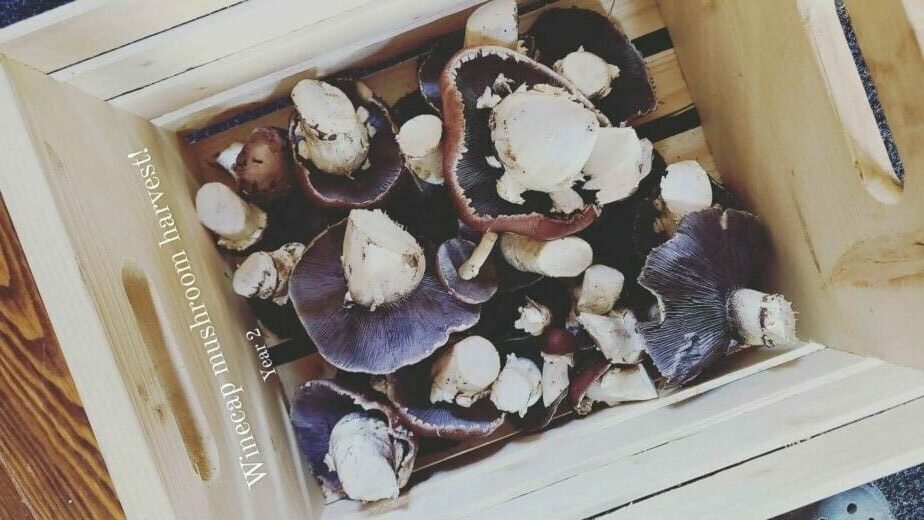
Harvesting wine cap mushrooms is pretty easy, but a few pointers can help with quality, storage, texture, and taste!
In general, the best time to harvest wine cap mushrooms is when temperatures are between 50-70°F (10-22°C) and have had a chance to air dry after rain. You’ll most likely find them in humid mild conditions, but when allowed to air dry, they are very clean to harvest, store better, and cook nicer!
- Check for mushrooms often to harvest fresh and young before pests get to them.
- Mushrooms typically pop up after or during the rain in mild temperatures between 50-70°F (10-22°C).
- If it’s raining for days, harvest and consume, or harvest, wash if needed, let dry off on towels, then store for a day or two, and consume sooner rather than later.
- If the rain is expected to subside in the next hours or days and you’ve got mushrooms popping up, wait until they air dry, they’ll store better in the fridge when air dried. They’ll also cook very nicely!
- When harvesting mushrooms it’s best to cut the stems with a sharp knife, leaving the beds undisturbed.
- Harvest a mushroom with the stem and taste both cap and stem. Do you like the taste of the stems? If not, cut your wine cap mushrooms at the top of the stems next time and leave the rest for critters.
- Harvest both young and large mature mushrooms to taste both. Once you learn your preferences, continue to harvest the way you like them!
Observations and Results
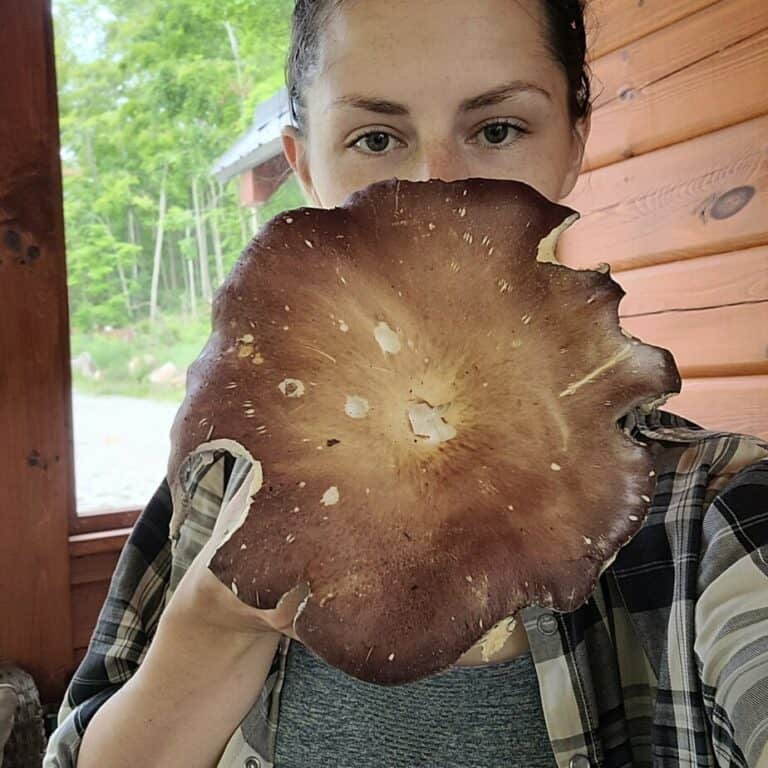
The fertility you get from wine cap mushrooms is amazing for plants! So long as you don’t over-mulch your plants, they’ll thrive with what’s left from the wine caps.
One thing I wish we did for our first wine cap bed was re-mulch it sooner! The first time we made a wine cap bed, was in spring. We got mushrooms in autumn and didn’t re-mulch it till the next spring.
Moving forward, I would do the first time re-mulching in autumn and every autumn. Mulching before winter has helped our wine caps stay more productive!
The plants benefit too because early spring weeds aren’t able to pop through as they normally would without the extra ‘floor.’
A final note
Wine caps aren’t the only mushroom you can grow as a companion in a wood chip garden. Many other species love wood chips.
Wine caps, however, are the easiest of all because they are the most aggressive mushroom that easily outcompetes other species.
If you’d like to cultivate other woodchip-loving mushrooms, consider designating a bed for them!
Up next: 6 Best Mushrooms for Woodchip Beds
Recent Posts
There’s no shortage of full-sun ground covers for zone 4 climates! Each plant in this list can withstand the frigid temperatures and also enjoy the hot sun in summer. Full sun means that a plant...
There's no shortage of full sun ground covers, not even in zone 3! Zone 3 climates offer hot but short-lived summers and very cold winters. So each plant in this list can withstand the frigid...
